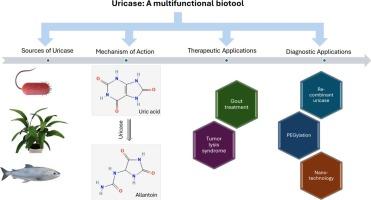Microbial uricase enzymes in hyperuricemia management: Sources, challenges, and technological advances
IF 1.9
4区 生物学
Q4 BIOCHEMICAL RESEARCH METHODS
引用次数: 0
Abstract
The downregulation of uric acid within the human body is intricately governed by the urate oxidase enzyme. This enzyme activity is notably present in various sources including microbial, plant, and certain animal origins. The normal concentration of uric acid in healthy individuals ranges from 3 to 6 mg/dl. However, abnormal conditions such as a high purine diet and tumor lysis syndrome can lead to elevated uric acid levels, constituting a primary etiological factor for hyperuricemia and gout. Recombinant uricases, such as rasburicase and pegloticase, have emerged as therapeutic interventions, effectively mitigating the severity of gout. Nonetheless, their utilization is constrained by immunogenicity and a relatively short half-life. Consequently, there is a compelling need for novel uricase variants characterized by lower immunogenicity and enhanced stability. This review aims to delineate alternative sources of uricase, elucidate their physico-chemical properties and clinical implications, and provide comprehensive insights into the potential of recombinant uricase. The significance of genetically modified uricase and polyethylene glycol (PEG)-conjugated uricase as highly promising treatment modalities for gout is emphasized. The application of uricase-based nanosensors, chips, biosensors, and nanocomposites for facile uric acid detection in samples is also highlighted. Given its considerable potential, uricase stands as a promising tool in the clinical realm for treating gouty and hyperuricemic conditions.

微生物尿酸酶在高尿酸血症管理中的应用:来源、挑战和技术进步。
人体内尿酸的下调是由尿酸氧化酶复杂地控制的。这种酶的活性明显存在于各种来源,包括微生物、植物和某些动物。健康人尿酸的正常浓度范围为3 ~ 6 mg/dl。然而,异常情况,如高嘌呤饮食和肿瘤溶解综合征可导致尿酸水平升高,构成高尿酸血症和痛风的主要病因。重组尿酸酶,如毛囊酶和pegloticase,已成为治疗干预措施,有效地减轻痛风的严重程度。然而,它们的利用受到免疫原性和相对较短的半衰期的限制。因此,迫切需要具有较低免疫原性和增强稳定性的新型尿酸酶变体。本综述旨在描述脲酶的替代来源,阐明其理化性质和临床意义,并全面了解重组脲酶的潜力。强调了基因修饰尿酸酶和聚乙二醇(PEG)偶联尿酸酶作为痛风极有希望的治疗方式的意义。重点介绍了基于尿酸酶的纳米传感器、芯片、生物传感器和纳米复合材料在样品中尿酸检测中的应用。鉴于其相当大的潜力,尿酸酶在治疗痛风和高尿酸血症的临床领域是一个很有前途的工具。
本文章由计算机程序翻译,如有差异,请以英文原文为准。
求助全文
约1分钟内获得全文
求助全文
来源期刊

Journal of microbiological methods
生物-生化研究方法
CiteScore
4.30
自引率
4.50%
发文量
151
审稿时长
29 days
期刊介绍:
The Journal of Microbiological Methods publishes scholarly and original articles, notes and review articles. These articles must include novel and/or state-of-the-art methods, or significant improvements to existing methods. Novel and innovative applications of current methods that are validated and useful will also be published. JMM strives for scholarship, innovation and excellence. This demands scientific rigour, the best available methods and technologies, correctly replicated experiments/tests, the inclusion of proper controls, calibrations, and the correct statistical analysis. The presentation of the data must support the interpretation of the method/approach.
All aspects of microbiology are covered, except virology. These include agricultural microbiology, applied and environmental microbiology, bioassays, bioinformatics, biotechnology, biochemical microbiology, clinical microbiology, diagnostics, food monitoring and quality control microbiology, microbial genetics and genomics, geomicrobiology, microbiome methods regardless of habitat, high through-put sequencing methods and analysis, microbial pathogenesis and host responses, metabolomics, metagenomics, metaproteomics, microbial ecology and diversity, microbial physiology, microbial ultra-structure, microscopic and imaging methods, molecular microbiology, mycology, novel mathematical microbiology and modelling, parasitology, plant-microbe interactions, protein markers/profiles, proteomics, pyrosequencing, public health microbiology, radioisotopes applied to microbiology, robotics applied to microbiological methods,rumen microbiology, microbiological methods for space missions and extreme environments, sampling methods and samplers, soil and sediment microbiology, transcriptomics, veterinary microbiology, sero-diagnostics and typing/identification.
 求助内容:
求助内容: 应助结果提醒方式:
应助结果提醒方式:


